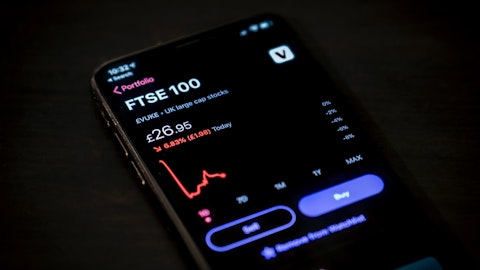Ragy Thomas: As we’ve articulated before, we’re seeing a very consistent theme and trend, especially among our larger customers, of consolidating across point solutions into platform. And this team of – the marketing team or the customer service them not being able to run 10, 15, 20 RFPs and then go hire a system integration vendor and then create data lakes, and it’s just too archaic. And so there’s a pronounced shift to having and wanting, let’s say, three to four companies to work together to provide a more complete front office capability set. And so, I think we are enjoying the benefits of being one of the options to consolidate onto. So we go and replace anywhere from sometimes 5, sometimes 15 and 20, over the years, different points solutions in different markets. So we’re positioning ourselves as the third or fourth vendor and benefiting from that consolidation.
Fiona Hynes: One follow up to that. As you make this transition and start to benefit from these consolidation trends that you’re talking about, are you seeing any changes in the persona that you’re selling to? So they think about the traditional Sprinklr, the buyer of the carrier solutions, not necessarily the same as the CCaaS solution? And so, I’m curious how that’s changing the end conversations that you have with the ultimate buyer for who you’re selling to?
Ragy Thomas: We have been steadily seeing that shift, the traditional buyer versus CMO’s organization and the CMO. With our expansion into CCaaS, that’s expanded to include the CIO, CDIO organization. So we are more broadly penetrating the C suite, everybody from a CMO to a CDO to now the CIO.
Operator: Our next question comes from the line of Brett Knoblauch with Cantor Fitzgerald.
Brett Knoblauch: The multi-year, $60 million contract, could you maybe provide a bit more color on that? I guess, how much bigger of an annualized value is the “new contract” relative to the old one? And then, more generally, just on the expansion motion, are you seeing your customers expand more so with additional seats from maybe social or is it more driven by new product expansion with maybe your CCaaS solution?
Ragy Thomas: In this case, I can confirm there was a material upsell in it. So this is again, as you would guess, one of our larger customers who, at the end of the term, again, had more to buy in, wanted to buy more. So that’s the answer to question number one. Question number two, are they buying more seats and more products, they are buying both. So in this particular case, we continue to believe that we have a list price of $25 million to $30 million of product payload that a large company can buy, if you want to deploy us across business units and across markets. In this case, they’ve already bought all four product suites and most of our products. So some were in ELA mode. So like we pointed out this time, listening is unlimited for the Insight product suite.
So, what we’re seeing is where the products are not unlimited in the ELA, they are expanding more seats. We talked about thousands more seats in social, but it’s not restricted to social. It’s more seats, more consumption and expanded license. And at some point, we expect these to end in unlimited use for most of our products.
Brett Knoblauch: Maybe if I could just follow-up with one question. I guess how frequently do you guys – I guess do customers do an ELA with you guys? Or is this one of the first ELA deployments you guys have done? Or do you see this trend kind of continue as you go forward?
Ragy Thomas: It’s infrequent. That’s something that we want to get to eventually. So this is a customer who has been with us for over 10 years. As you know, our sales approaches traditionally and currently being bottoms up. So we’d like to get in with – in a market for the product suite one of our offerings and then build credibility and go bottom up. So it’s typically a multiyear journey. And it builds momentum as bottom up success is embraced by an executive who sees the overarching ability to unify and get better business outcomes.
Operator: Our next question comes from the line of Michael Turits with KeyBanc.
Michael Turits: Solid quarter. Wanted to ask some more questions about self-service? So, first, a couple. So, the self-service deals that you’ve done or have taken self-service, is that primarily in land or expand? And what have been the customer sizes versus relative to your typical customer sizes? And then I have two more details around that same question.
Ragy Thomas: Self-service, for us, has been a strategy to make sure that we have our defenses lined up, right, to make sure that no one’s attacking us from downstream in the long run. In the short run, our focus has been trying to give the practitioner more exposure to the power of Sprinklr, get hands on keyboard. And you know that we’re very, very solidly focused on our target ICP, ideal customer profile – on our ICP and we’ve identified 43,000 companies as fitting that profile in our target market. So our strategy has been making these products available for everyone – you can go sign up – but directing our marketing and advertising and outreach only to those 43,000 companies. And we only follow up and encourage when a customer fits our target profile.
And one of two things happen as they come in. Usually, sometimes it’s like a small team that wants to try it for a bit and they can do so. And in many times, which we’re seeing – what we’re hoping to see and what we’re seeing is they try it and they realize that, okay, this is powerful and easy to use, and they talk to our sales team and buy the enterprise version. We are beginning to see now – again, this is, as most things, strategic. It’s going to take us several quarters, but every quarter we’re seeing increasing green shoots come from this approach. And we’re very encouraged by how it’s progressing.
Michael Turits: So just two follow-ups on that, Ragy and Manish. Is it possible to tell you if this is actually reducing your average customer acquisition costs and it is actually reducing the time to deployment for analogous types of build?
Ragy Thomas: It’s too early. We’ve got a few trends kind of going back and forth. One is, as we get into CCaaS, as you know, deal cycles take longer because it’s a very thorough process. CCaaS transitions are very hard and they are very – customer service teams are very risk averse. So it’s a much more longer thought-out, deliberate, RFP/RFI kind of process that takes time. So on the self-service side, we’re able to kind of gain some of those momentum, have a deal open and close within the quarter to offset it. But, again, these customers are coming to us in the self-service, trying it out tend to be, at least on an average, smaller in the first deal site.
Operator: Our next question comes from the line of Michael Berg with Wells Fargo.
Michael Berg: Congrats on the quarter. I just wanted to have more of a philosophical view on your guidance. You obviously had a very strong quarter and being raised by more than the beat, like you said, and more than the Q3 raise. So, maybe what’s providing that confidence? Is there anything outside of the strong renewal activity and the large deals you saw in the quarter? Maybe just help us parse through what’s giving you the confidence and the guidance?




